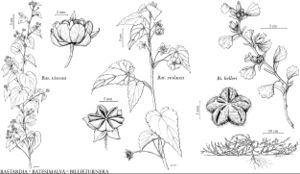Bastardia viscosa
in A. von Humboldt et al., Nov. Gen. Sp. 5(fol.): 199.
5(qto.): 256. 1822.
Illustrated
Basionym: Sida viscosa Linnaeus Syst. Nat. ed. 10, 2: 1145. 1759
Synonyms: Bastardia guayaquilensis Turczaninow B. parvifolia Kunth S. bastardia de Candolle S. foetida Cavanilles
Treatment appears in FNA Volume 6. Treatment on page 237.
Revision as of 00:40, 28 May 2020 by imported>Volume Importer
Plants 0.5–1.5 m. Stems often malodorous, sometimes also with simple hairs 2 mm. Leaf blades 4–8 cm (often smaller), apex acute to acuminate. Inflorescences usually leafy panicles. Pedicels slender. Flowers: calyx 4–5 mm, viscid; corolla usually 6+ mm, petals 4–5 mm. Schizocarps 5–6 mm diam.; mericarps muticous. Seeds 2 mm. 2n = 28.
Phenology: Flowering year-round.
Habitat: Shrublands, thickets, disturbed vegetation, pastures, roadsides
Elevation: 0–500 m
Distribution

Tex., e Mexico, West Indies, Central America, South America (Colombia, Ecuador, Peru, Venezuela).
Discussion
Bastardia viscosa is known only from the lower Rio Grande valley.
Selected References
None.
Lower Taxa
None.
